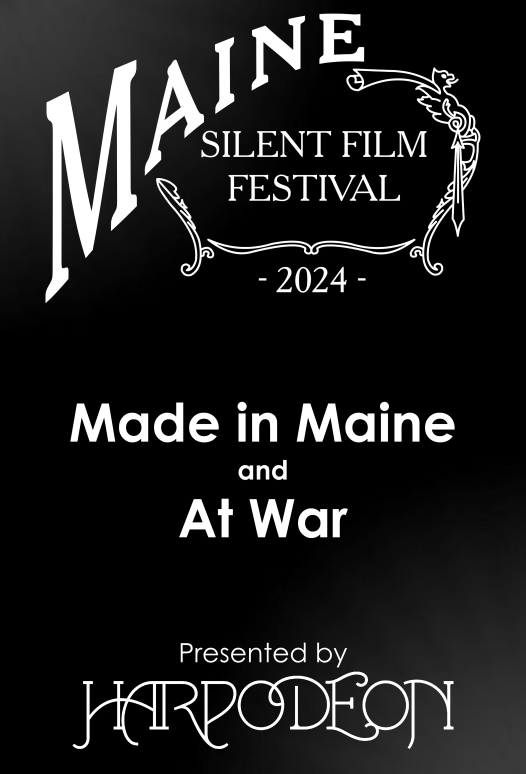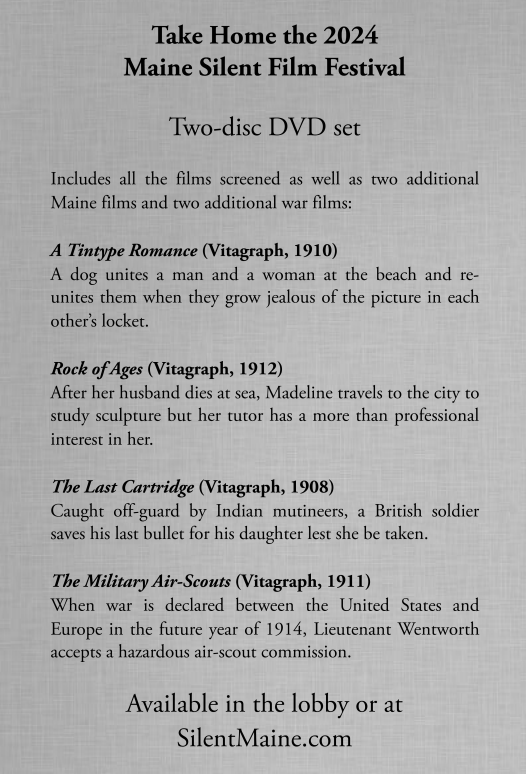

Made in Maine
When actualities gave way to narrative films at the turn of the twentieth century, filmmaking became a studio-bound industry. Nearly all of the pioneering production companies were based in the northeast, where weather conditions were often uncooperative for outdoor shooting.
It was 1896 when Klieg carbon arc lights became available. Early film stocks were very slow, meaning they required a tremendous amount of light to register an image—nothing short of full sunlight. Klieg lights were the first practical source of artificial lighting bright enough to supplant the sun and filmmakers were quick to adopt them. In indoor studios, they were no longer beholden to unpredictable sun, wind, or rain and could produce more films in less time.
In some ways, it was a step forward, but in others, it was a step back. Audiences were never fooled by backdrops made of painted canvas flats when they saw them on stage in live theatre and they were no more fooled by them on the screen.
Meanwhile, independent studios—those who came into business after the pioneers and who were not members of the Motion Picture Patents Company (more commonly called the Patents Trust) which held the patents to much of the technology
needed for filmmaking—were moving to the west coast. This was largely to get as far away from New York and the Patents Trust lawyers as possible, but it also ushered in a new kind of filmmaking.
The independents did not have the money to build studios but the climate of Southern California was far more amenable to shooting outside. And though the films they produced were made for a fraction of a Trust studio’s budget, because they were shooting on real locations, their films looked more authentic than films shot on a painted canvas set.
It came to be called location shooting.
Not to be outdone, the Trust companies—viz. Edison, Biograph, Vitagraph, Lubin, Selig, and Essanay—began shooting films on location, too, sending production teams south to Florida and Mexico, to the wilds of northwest Canada, and across the sea to Ireland and France. But the locations were not always so far afield; Trust studios did not neglect scenic places closer to their northeastern home.
Without the cowboys and Indians tropes that characterized westerns and so well suited the deserts and plains where the independents filmed their productions, the Trust companies had to create its own outdoor genre: the eastern. Easterns dealt primarily with farming, fishing, boats, and ships. In eastern dramas, the story’s central conflict is frequently
driven by puritanical morals and obsessive class consciousness.
Lubin’s foray into Maine found its way to Cape Elizabeth, where director Barry O’Neil’s team established a temporary tent city that they dubbed Lubinville-by-the-Sea to shoot easterns on location. The appropriately titled Just Maine Folks was one of those easterns made in Maine. Released in 1912, the film follows the comic exploits of two farmers both hoping to win a widow’s heart, and the spooky stories told at the moonlight harvest festival that gives one of the farmers an idea for how to scare off his rival.
Laurence Trimble, director for Vitagraph, twice took his team to Maine, shooting A Tintype Romance and Rock of Ages at Old Orchard Beach, and The Men Haters Club in Standish on the shores of Sebago Lake and aboard the Sebago Lake-Songo River-Bay of Naples Steamboat. In the last-named film, released in 1910, Florence and her friends abandon their respective fiancés after discovering them to be unfaithful and go on a girls-only camping trip, but the boys are following not far behind and hope to win them back.
In the later era of silent feature films, Maine continued to be a popular setting, but rarely were the films actually shot here. Perhaps D.W. Griffith’s second most well-known film, Way Down East, while set
in Maine, was shot primarily in New York with a few scenes taken in Connecticut and Vermont. Meanwhile, the Lon Chaney vehicles The Miracle Man and Shadows were filmed entirely in California, with Monterey Bay representing the rocky New England coast as it so often does in the movies.
One studio that did actually film in Maine was Portland-based Dirigo Films. Although organized with the hopes of becoming a major production company, Dirigo would only release two films before it folded, both in 1922. Their first, Jan of the Big Snows, adapted from the James Oliver Curwood novel, is believed to be lost. Their second, an adaptation of Maine author Kate Douglas Wiggin’s novel Timothy’s Quest, survives.
Set in Pleasant River although filmed in Hollis, Timothy’s Quest follows two orphans from the slums of Boston who, when threatened with separation, run away to rural Maine. Following a vision, the two find their way to a farm owned by an unyielding woman embittered by the memory of her sister giving birth to an illegitimate child and the guilt she feels for abandoning her.
At War
While Cecil B. DeMille would famously observe late in the silent era that you can get any amount of sex and violence past the censors so long as you gave it a veneer of religion, filmmakers were quite aware of that in the early days as well.
Henri Andréani, director for the Comédie-Française, produced many short films with biblical themes in the first half of the 1910s. Among the most popular was 1912’s Absalom, an account of the eponymous prince rebelling against his father, King David, when passed-over in the succession in favor of his younger brother Solomon, culminating with the climactic Battle of Ephraim’s Wood, featuring hundreds of costumed extras in one of the largest battle scenes yet filmed.
At the same time in America, moving pictures were still viewed with suspicion. Unlike legitimate theatre, going to the movies could be afforded by any class of people, and the silent screen being pantomime, it attracted even recent immigrants unable to speak English. All of this frightened the establishment immensely.
A new kind of film was needed—one that would instill proper respect for American culture, or at least the Anglocentric version of it with which the establishment chose to identify. Nearly
every pioneering studio released such titles. Variously styled High Art Films or Films De Luxe, the chief producer of the genre was Vitagraph, where they were termed Quality Films.
Quality Films were less made to be watched as they were to placate, but at times they could be entertaining. The Victoria Cross hits all the right notes of a Quality Film: it is educational, depicting a proud moment in English history—the Crimean War; it is a biography of a respected English personage—Florence Nightingale; and it is adapted from the work of a great English poet—Alfred, Lord Tennyson. But ignoring all of that, The Victoria Cross is also an action film calculated to thrill an audience.
Curiously, Edith Storey, who plays a woman that joins with Florence Nightingale as a nurse on the Crimean front lines, would in real life join the military in the First World War as a front-line ambulance driver.
From war films set in the past, we come to those contemporary with the film’s release.
The Mexican Revolution, having only just broken out the year before and with hostilities still ongoing, is the topic of Across the Mexican Line, directed by Alice Guy-Blaché for Solax, her own studio, in 1911. The first of her “Big Military Features” series, it follows a female spy with orders to insinuate herself into an American lieutenant’s
favor and to report to a Mexican general the movements of the American troops.
And lastly, going from a contemporary dramatic spy film, we end with a contemporary comedic spy film: Yankee Doodle in Berlin. In this, his only film appearance, Bothwell Browne stars as an American spy who disguises himself as a woman in order to seduce the Kaiser into revealing Germany’s war plans. Bothwell Browne, alongside Julian Eltinge, were among the most widely known drag performers of their time.
The outbreak of the First World War led to a glut of bleak and ponderous propaganda films like Hearts of the World, and as the fighting wore on with no sign of abating, audiences were left exhausted. Films lampooning the war like Yankee Doodle in Berlin or Chaplin’s Shoulder Arms served as a cathartic, allowing one to laugh again.
Our Accompanist, Doug Protsik
Doug learned the art of putting together a score appropriate for silent movies from Danny Patt, who accompanied silent movies in Union, Maine in the 1920s—a time when it was the job of piano players to accompany the films since there was no sound. Since Danny passed away in 1999, Doug has been continuing this tradition performing the “Old Time Piano” style and has scored and performed for countless showings throughout Maine and internationally. This work led to his composing original authentic scores for silent movie restorations for Turner Classic Movies, including titles such as Hitchcock’s The Lodger and Easy Virtue.
Using old sheet music from Danny’s collection, as well as researching at the Bagaduce Music Lending Library in Blue Hill, Maine, his scores attempt to capture the unique flavor with the music as it embellishes the action on screen, in an original and authentic way. Doug also has established a fun aspect to the performances by including “musical jokes” in his scores, challenging the audience to recognize them. All the music is memorized, arranged, and improvised by Doug to allow for a seamless flow from scene to scene. Attending a performance allows for a wonderful musical, as well as an historic and entertaining film experience.



